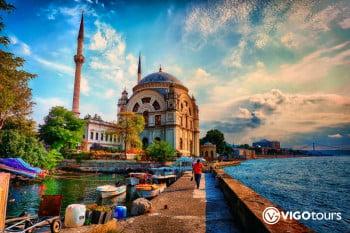Topkapi Palace (Topkapi Sarayi) is one of Istanbul’s most remarkable historical sites, offering visitors an intimate look at the opulence of the Ottoman Empire and its royal heritage. Located on the Seraglio Point overlooking the Bosphorus, this sprawling palace complex was the primary residence of the Ottoman sultans for nearly 400 years and remains a symbol of the empire's grandeur and cultural richness.
1. Historical Overview
Overview: The origins and significance of Topkapi Palace
Topkapi Palace was commissioned by Sultan Mehmed II, known as Mehmed the Conqueror, shortly after the fall of Constantinople in 1453. The palace served as the administrative and residential heart of the empire, where sultans ruled and hosted dignitaries from around the world. Over the centuries, it underwent various expansions and renovations, reflecting the changing tastes and needs of the sultans.
The palace complex was home to thousands of people, including royal family members, officials, servants, and guards. It was not only a residence but also a center of governance, culture, and art, making it an integral part of the Ottoman Empire's identity.
2. Architectural Features
Overview: The design and layout of Topkapi Palace
Topkapi Palace showcases a unique blend of Islamic and Byzantine architectural styles, featuring a series of courtyards, gardens, and buildings:
- Main Gate (Bab-i Hümayun): The entrance to the palace is marked by the grand gate known as Bab-i Hümayun, adorned with intricate carvings and inscriptions.
- First Courtyard: This open area serves as a public space where visitors can explore the gardens and enjoy views of the Bosphorus. It also includes the Imperial Mint and the palace kitchens, showcasing the daily life of the palace.
- Second Courtyard: This courtyard houses the Audience Hall (Arz Odasi) and the Imperial Council Hall, where important state affairs were conducted. The ornate architecture and beautiful tile work highlight the artistic craftsmanship of the time.
- Third Courtyard: The most exclusive area of the palace, this courtyard includes the harem, the sultan’s private residence, and the Imperial Treasury, where valuable artifacts and treasures are displayed.
3. Cultural and Historical Significance
Overview: The role of Topkapi Palace in Ottoman culture
Topkapi Palace is not just a royal residence; it is a treasure trove of history, art, and culture:
- Cultural Hub: The palace was a center for art and culture during the Ottoman Empire, fostering the development of various art forms, including calligraphy, miniature painting, and ceramics. The palace’s extensive collection of artifacts reflects the empire’s rich artistic heritage.
- Harem: The harem, a unique feature of the palace, was the private quarters of the sultan’s family, including his wives, concubines, and children. It provides insight into the social dynamics of the royal family and the roles of women in the empire.
- Imperial Treasures: The Imperial Treasury houses a remarkable collection of jewels, gold, and priceless artifacts, including the famous Topkapi Dagger and the Spoonmaker's Diamond. These treasures offer a glimpse into the wealth and power of the Ottoman sultans.
4. Visiting Topkapi Palace
Overview: What to expect during your visit
A visit to Topkapi Palace is a journey through the opulence of the Ottoman Empire:
- Entrance and Admission: The palace is located in the Sultanahmet district and requires an entrance ticket. Audio guides are available to enhance your experience and provide detailed information about the various exhibits.
- Opening Hours: Topkapi Palace is generally open daily, but it's advisable to check the official website for seasonal hours and special closures.
- Guided Tours: Consider joining a guided tour to gain deeper insights into the palace’s history, architecture, and artifacts. Many tours also include access to the harem and the treasury.
5. Practical Tips for Visiting
Overview: Ensuring a smooth visit to Topkapi Palace
To make the most of your experience at Topkapi Palace, consider the following tips:
- Best Time to Visit: Early mornings or late afternoons are ideal for avoiding crowds. Weekdays tend to be less busy than weekends.
- Dress Code: While there is no strict dress code, visitors are encouraged to dress modestly and comfortably, as there is considerable walking involved.
- Photography: Photography is allowed in many areas of the palace, but be respectful of signs indicating restricted areas.
Conclusion
Topkapi Palace is a stunning testament to the grandeur of the Ottoman Empire and offers an enriching experience for visitors. Its magnificent architecture, rich history, and exquisite artifacts provide a window into the lives of sultans and their courts. A visit to Topkapi Palace is not just a journey through history; it is an exploration of the cultural and artistic achievements that shaped one of the most influential empires in history. Whether you are captivated by its architecture, fascinated by its treasures, or intrigued by its stories, Topkapi Palace promises an unforgettable experience in the heart of Istanbul.
Click here now: Places to See in Istanbul

